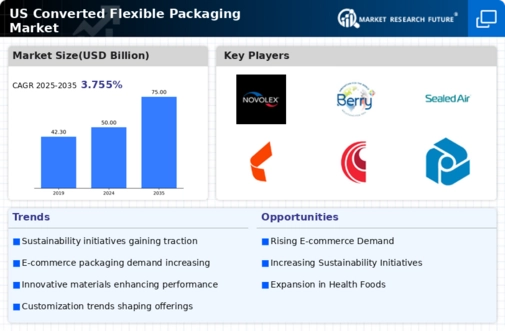Health and Safety Regulations
Stringent health and safety regulations significantly influence the converted flexible packaging market. Regulatory bodies are increasingly enforcing standards that ensure the safety of packaging materials, particularly in food and pharmaceutical applications. Compliance with these regulations is essential for manufacturers, as non-compliance can lead to substantial financial penalties and reputational damage. The market is adapting to these requirements by investing in safer materials and processes. This focus on regulatory compliance is projected to contribute to a market growth rate of approximately 3.5% over the next few years, as companies prioritize safety in their packaging solutions.
Growth of the Snack Food Sector
The robust growth of the snack food sector benefits the converted flexible packaging market. As snacking becomes a more prevalent eating habit among consumers, the demand for flexible packaging solutions that cater to this trend is increasing. The snack food industry is projected to expand at a CAGR of around 4.5% through 2026, creating opportunities for packaging innovations. Flexible packaging offers advantages such as extended shelf life and reduced waste, making it an attractive option for snack manufacturers. This growth in the snack food sector is expected to significantly contribute to the overall expansion of the converted flexible-packaging market.
Rising Demand for Convenience Packaging
The converted flexible-packaging market is experiencing a notable surge in demand for convenience-oriented packaging solutions. As consumer lifestyles evolve, there is a growing preference for products that offer ease of use and portability. This trend is particularly evident in sectors such as food and beverage, where ready-to-eat meals and single-serve packages are gaining traction. According to recent data, the convenience packaging segment is projected to grow at a CAGR of approximately 5.2% through 2026. This shift towards convenience is compelling manufacturers to innovate and adapt their offerings, thereby driving growth in the converted flexible-packaging market.
Technological Advancements in Packaging
Technological innovations are playing a pivotal role in shaping the converted flexible-packaging market. The integration of advanced materials and production techniques is enhancing the functionality and appeal of packaging solutions. For instance, the development of high-barrier films and biodegradable materials is addressing both performance and environmental concerns. Furthermore, automation in production processes is improving efficiency and reducing costs. The market is expected to witness a growth rate of around 4.8% annually, driven by these technological advancements. As companies strive to meet consumer expectations, the emphasis on innovation is likely to remain a key driver in the converted flexible-packaging market.
Consumer Preference for Eco-Friendly Products
There is a shift in consumer preferences towards eco-friendly packaging solutions in the converted flexible packaging market. As awareness of environmental issues grows, consumers are increasingly seeking products that utilize sustainable materials and practices. This trend is prompting manufacturers to explore alternatives such as recyclable and compostable materials. Recent surveys indicate that nearly 70% of consumers are willing to pay a premium for sustainable packaging options. This consumer-driven demand is likely to propel the growth of the converted flexible-packaging market, as companies strive to align their offerings with the values of environmentally conscious consumers.






















Leave a Comment